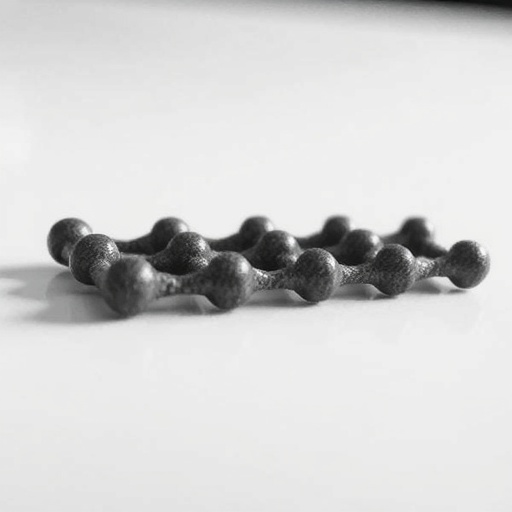In a groundbreaking study published in 2025, researchers Khan, Zubair, and Farooq have unveiled a novel composite material that could revolutionize the field of environmental remediation. This innovative material, Co₁₂V₈O₃₂/ZnO, has demonstrated exceptional efficiency in the photodegradation of methylene blue, an organic dye notorious for its adverse environmental effects, particularly in water bodies. The study highlights the potential application of this composite under visible light irradiation, a significant advancement when compared to traditional methods that often rely heavily on ultraviolet light.
The motivation behind this research stems from the increasing concern over water pollution and the detrimental impact of dyes like methylene blue on aquatic life and human health. Methylene blue, widely used in various industries, poses serious risks as it contaminates water sources, making it imperative to develop efficient degradation methods. By harnessing the unique properties of the Co₁₂V₈O₃₂/ZnO composite, the research team aims to provide a sustainable solution for mitigating the effects of such pollutants.
The synthesis of the Co₁₂V₈O₃₂/ZnO composite involves a meticulous process that optimizes the interaction between cobalt, vanadium, and zinc oxide. The researchers employed advanced techniques to achieve a homogenous distribution of the active components within the composite, which is critical for enhancing the photocatalytic activity. This careful fabrication method ensures that the resulting material exhibits superior light absorption capabilities, critical for effective photodegradation under visible light.
One of the standout features of this composite is its ability to generate reactive oxygen species (ROS) when exposed to visible light. ROS play a pivotal role in the photocatalytic process by facilitating the breakdown of methylene blue into less harmful compounds. The study revealed that the Co₁₂V₈O₃₂/ZnO composite significantly increases the concentration of ROS, thereby accelerating the degradation process. This characteristic not only enhances the efficiency of the treatment but also reduces the time required for effective decontamination of polluted water.
In laboratory experiments, the Co₁₂V₈O₃₂/ZnO composite demonstrated remarkable stability and reusability. Unlike many other photocatalysts that lose efficacy after several cycles, this composite maintained its performance even after repeated use. Such durability is a crucial attribute that could lead to significant cost savings in real-world applications. The researchers believe that this could foster greater adoption of photocatalytic processes in water treatment facilities and other industrial applications.
The findings of this study have far-reaching implications for environmental management, especially in regions where water pollution is a pressing concern. By employing a composite capable of functioning effectively under visible light, water treatment facilities could operate more efficiently, reducing their reliance on energy-intensive UV light systems. This shift not only aligns with sustainability goals but also democratizes access to advanced water treatment technologies across various economic contexts, including developing nations.
Moreover, the research team conducted an extensive comparison of their Co₁₂V₈O₃₂/ZnO composite with other photocatalysts, showcasing its superior performance. Their findings indicate that this new material boasts a higher degradation rate and more extensive absorption spectrum. Such advantages position it as a competitive alternative in the growing market for photocatalytic materials, which has traditionally been dominated by well-established materials like TiO₂.
As awareness of environmental issues becomes more pronounced, the development of such innovative materials is crucial. The Co₁₂V₈O₃₂/ZnO composite not only meets the immediate needs for dye degradation but also opens avenues for further research into similar materials capable of degrading a broader spectrum of pollutants. Future studies can build upon these findings to explore additional applications, including the degradation of pharmaceutical residues or heavy metals in wastewater.
In light of the escalating concern regarding the chemical pollutants entering our waterways, the introduction of effective materials like Co₁₂V₈O₃₂/ZnO is not merely an academic achievement but a necessity. With the increasing incidence of waterborne diseases linked to industrial effluents, the urgency for efficient remediation solutions cannot be overstated. The flow of innovation in this field could play a crucial role in safeguarding public health and preserving aquatic ecosystems.
The success of this research study underscores the importance of collaboration across disciplines, combining materials science, chemistry, and environmental engineering. Such integrations are essential for addressing the multifaceted challenges posed by environmental pollution. The findings serve as a rallying point for researchers and practitioners alike, advocating for the application of cutting-edge materials in real-world scenarios.
As the publication makes its way through the scientific community, the potential for the Co₁₂V₈O₃₂/ZnO composite to become a cornerstone in future environmental remediation efforts appears promising. It invites further investigation and development, encouraging a multidisciplinary approach to tackling pollution. By integrating science, technology, and environmental stewardship, the research holds the potential to effect real change in the methods we employ to protect our planet.
In summary, the research led by Khan, Zubair, and Farooq heralds an exciting advancement in photodegradation technologies with the Co₁₂V₈O₃₂/ZnO composite. This study not only identifies a highly effective material for the degradation of methylene blue under visible light but also emphasizes the necessity of sustainable practices in environmental management. The implications of these findings extend far beyond laboratory settings, promising a future where polluted water could be efficiently treated through innovative, low-energy solutions.
Subject of Research: Development of Co₁₂V₈O₃₂/ZnO composite for photodegradation of methylene blue
Article Title: Novel Co₁₂V₈O₃₂/ZnO composite for efficient photodegradation of methylene blue under visible light irradiation
Article References:
Khan, M.D., Zubair, A., Farooq, M.u.H. et al. Novel Co12V8O32/ZnO composite for efficient photodegradation of methylene blue under visible light irradiation.
Ionics (2025). https://doi.org/10.1007/s11581-025-06771-7
Image Credits: AI Generated
DOI: https://doi.org/10.1007/s11581-025-06771-7
Keywords: Photocatalysis, Environmental remediation, Methylene blue degradation, Composite materials, Reactive oxygen species, Water treatment technologies.
Tags: advanced degradation methodsaquatic life protectionCo12V8O32 ZnO compositecobalt vanadium zinc oxide synthesisenvironmental remediationinnovative composite materialsmethylene blue degradationorganic dye treatmentphotocatalytic activitysustainable materials for water purificationvisible light photodegradationwater pollution solutions





